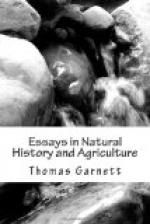ducks frequented the spawning ford, and the superintendent
bought one, and found its crop quite full of Salmon
roe. If this had been buried eighteen inches in
the gravel (as Salmo Salar suggests), the duck would
have had some difficulty in extracting it; but so
far as my experience goes, it is not usually one-half
that depth, although this varies in different rivers.
Then, if one Salmon is able to plough up gravel which
is cemented together by sand and long continuance
in one place, why should not another be able to do
the same when the gravel is loose and easily removed?
But there is another enemy whom Salmo Salar has not
mentioned, who does more harm than all the rest:
that is the poacher, and I fear that many of the Salmon
which Salmo Salar saw spawning in the Hodder and its
tributaries have since then made a journey overland.
At all events, I am credibly informed that in one
season a gang of poachers took seventy Salmon in the
Hodder. Is he sure they have taken none this
season? Salmo Salar seems to think that one pair
of Salmon will not spawn on the same ground, which
has been previously occupied by another pair; but he
has only to watch the same ridd for a week or two
to be convinced he is mistaken. As to fish refusing
to spawn on new gravel, I may state that when Mr.
Fawkes was making his experiments at Farnley he put
some new gravel into his brook, and there were sixteen
pairs of Trout spawning on it the next morning.
Salmo Salar says that if he can have those simple
checks which he enumerates to the present practices,
he will restore abundance of Salmon to the Ribble;
they are all very good in their way, but do not go
quite far enough, and they would do very little good
without a fourth, namely, protection from the poacher
for the fish on the spawning beds. Until this
can be given more efficiently than it is at present,
all the rest will be unavailing; and until the upper
proprietors can have a greater interest in the preservation
of Salmon than they now have, they cannot be expected
to give themselves much trouble on the subject.
My readers would not be much edified by strong assertion
and counter-assertion of what Trout do, and what they
cannot do; nor is it probable that where we differ
we should convince each other; neither do I see any
occasion for personality, when both parties are actuated
by the same motives—a desire to see the
Salmon fisheries restored to a state of great prosperity.
I therefore avoid noticing some of Salmo Salar’s
remarks, which seem to me a little tinged with this
spirit, and hope we shall be able to act in concert
for the attainment of that desirable result. Salmo
Salar will find that the number of Smolts is not always
determined by the quantity of ova deposited:
if he will examine the bed of the Hodder the next
low water, he will find many of the ridds disturbed
by the ice floods of yesterday; and if he doubts this,
I shall be happy to examine them along with him, if
he will give me previous notice of his intention.




